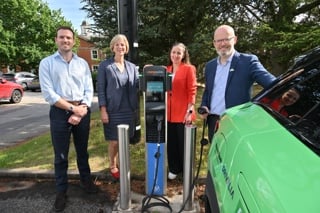Organisations are being urged to ensure their workplace electric vehicle charging infrastructure is preventatively maintained to optimise fleet operations.
A recent survey by Drax Electric Vehicles found 48% of large businesses have already installed charge points at their sites, but if they stop working then it can have significant knock-on effects.
These include unexpected delays, interruptions to operations, higher costs as drivers may be forced to use more expensive public charging and safety risks as damaged or faulty chargers are a hazard.
Additionally, if the business allows the public to use its rapid charge points then they could face regulatory penalties as public rapid chargers must meet a 99% uptime target.
Naomi Nye, head of sales – EV charging at Drax Electric Vehicles, said: “Used strategically, workplace charging allows drivers to top-up while vehicles are idle – during rest breaks, loading times or shift changes.
“When paired with energy storage or renewable sources like solar, these systems can cut costs and reduce emissions. It’s a win-win.
“While you can’t prevent every fault, a proactive maintenance plan goes a long way toward protecting your fleet and your reputation.”
The Government’s Workplace Charging Scheme has funded around 60,000 installations since it was introduced in 2016.
It provides up to £350 (or 75%) towards the cost of the charger and installation for up to 40 sockets per applicant and sets out some of the requirements for ensuring they stay operational.
All government-funded chargers must include a three-year parts and labour warranty, which means the installer or manufacturer is responsible for fixing any faults as they arise.
But damage and vandalism fall outside that scope, and service packages aren’t mandatory or included in the grant.
Nye said: “That means it’s up to the fleet operator to keep equipment in good working order. Regular inspections and documentation are essential – not just for performance, but to limit liability if things go wrong.”
Relevant rules and guidelines include:
BS 7671 Wiring Regulations, which require regular inspections by a qualified electrician, at intervals determined by a risk assessment. Residual current devices (RCDs) must be tested every six months, and some are inside the charger.
The Health and Safety at Work Act puts a legal duty on businesses to ensure equipment is properly maintained and safe to use. This includes regular checks for damage and deterioration of electrical systems, adjusted based on the frequency of faults, with inspections by qualified electricians.






















Login to comment
Comments
No comments have been made yet.